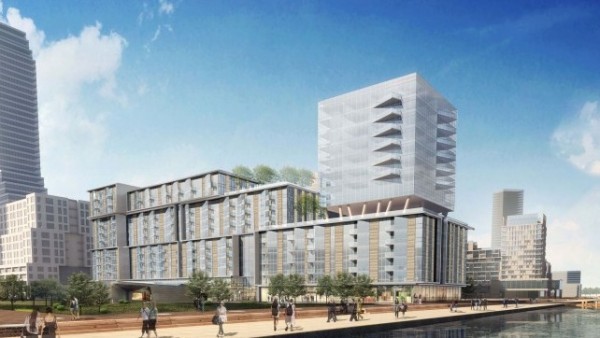
Cross-posted from No Mean City, Alex’s personal blog on architecture![]()
I haven’t touched on the waterfront very often this year (I was busy elsewhere during the discussion of Doug Ford’s Wild Waterfront Kingdom), but a recent interview with Rem Koolhaas raises some interesting ideas about the waterfront and what he calls “assembly-line cities.”
Koolhaas, the most voluble and brilliant of star architects, recently spoke with the German newspaper Der Spiegel at its new offices on Hamburg’s waterfront. The building – home to Spiegel and its media conglomerate – is part of Hafen City, the single largest waterfront redevelopment in the West. Hafen City is similar in scope and style to what’s happening on Toronto’s waterfront: an industrial port land, much larger in Hamburg, is being converted to residential, office and commercial spaces with careful urban design and good architecture.
And what does the great Rem say about it? He notices that the journalists are whispering in their own workplace, and (ever the troublemaker) picks on them to make a larger point.
Koolhaas: You seem a little unhappy with this building that was built for you. And you are skeptical about this new neighborhood in which the building is located. I get the feeling that what you need from me isn’t so much an interview as an hour of therapy.
SPIEGEL: Isn’t skepticism appropriate?
Koolhaas: Perhaps. But I can’t comfort you. Nowadays, and everywhere, we are in a situation in which many things are interacting and producing results like this building or this HafenCity. It doesn’t matter whether it’s in Hamburg, Dubai or China. It would be easy to say: “The architect has failed” or “The city has failed” or “The evil consortium of investors is to blame.” No, it’s the interplay of all these conditions that produces soulless buildings.

There is a danger that we will wind up with that effect here. Not overall, perhaps – there are too many developers involved and too many instiutions. Many architects too. But in individual cases, such as the Bayside neighbourhood being developed by the international real estate company Hines, who knows? That’s a rendering of Bayside at the top – which, to be fair, is extremely early and doesn’t show any of the actual architecture that will come out of the design process. However, the adjacent Sherbourne Common park is basically done, and it is gorgeous.. but a little sterile; it would be improved by some small restaurants and street vendors nearby, a dose of chaos, even something ugly.
In short, big and uniform are not good things in cities. There’s some insurance in the fact that Waterfront Toronto has enlisted some very good people in its planning apparatus, including Ken Greenberg, who I know shares these views and backs them with vast experience.
But still. How often does Rem, the apostle of globalism and bigness, sound like Jane Jacobs? It’s important we try and avoid yet another multi-generational mistake, even it happens by doing too much.
Happy holidays. I’ll see you next week, and again in 2012.

